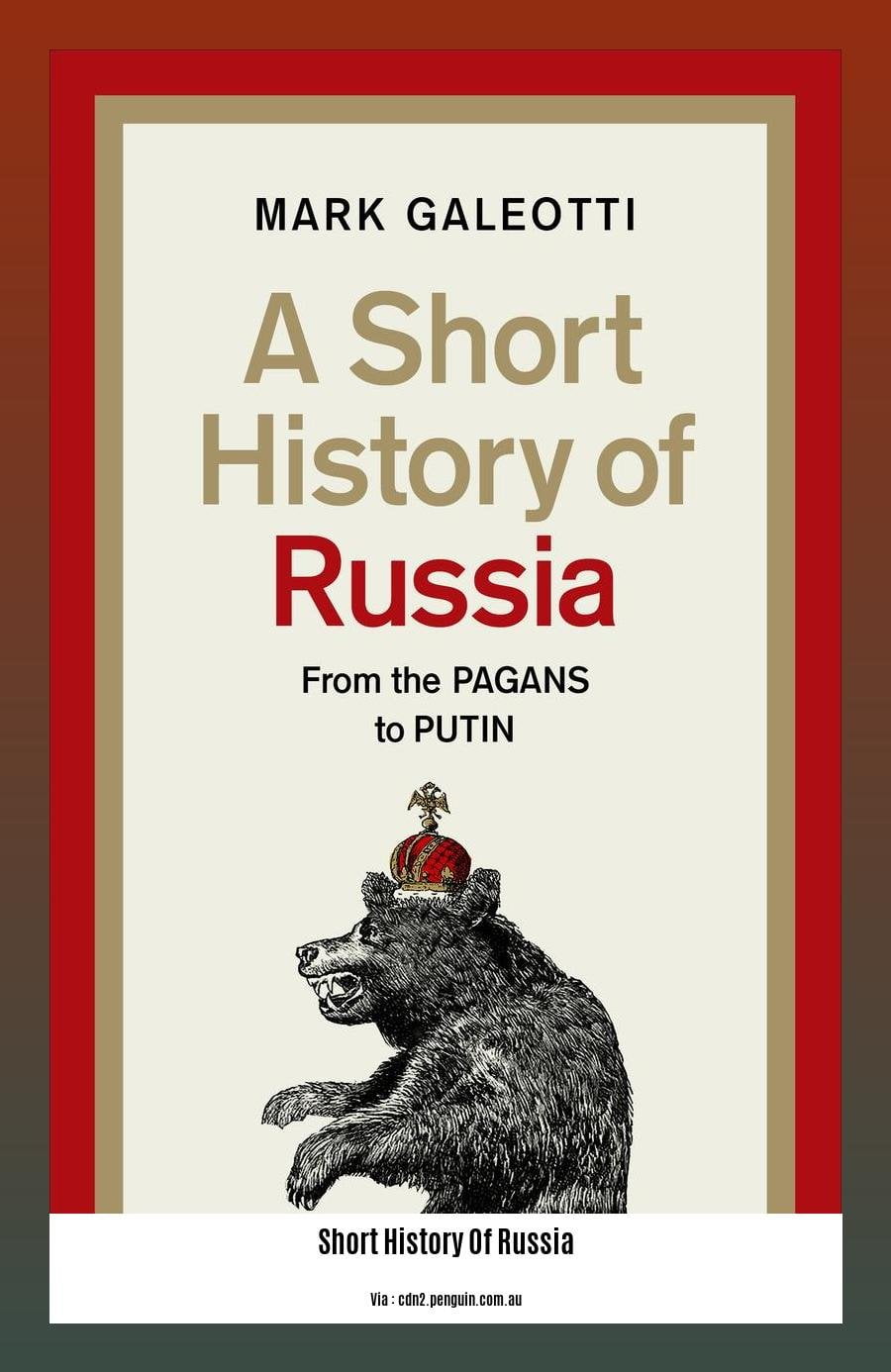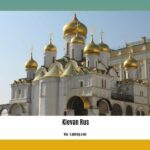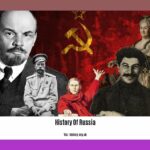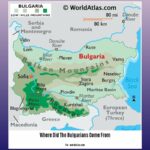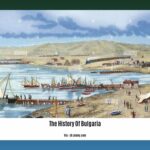Embark on a captivating journey through the annals of Russian history, a land of tsars, revolutions, and profound transformations. In this article, [A Short History of Russia: From Tsars to Revolutions and Beyond], we delve into the rich tapestry of Russia’s past, exploring its evolution from a medieval principality to a global superpower. Prepare to be enthralled as we uncover the stories of iconic rulers, momentous revolutions, and the resilience of the Russian people.
Key Takeaways:
Kievan Rus, the first major East Slavic state, was founded in 862 AD.
During the 13th century, Kievan Rus faced invasion by the Tatars, resulting in a decline.
From 1547 to 1584, Ivan IV “the Terrible” became the first Tsar of Russia and expanded its territory.
Peter the Great modernized Russia and founded St. Petersburg during his reign from 1682 to 1725.
Catherine the Great extended Russia’s borders and strengthened its position as a European power from 1762 to 1796.
Napoleon Bonaparte’s failed invasion of Russia in 1812 marked a turning point in the Napoleonic Wars.
The Russian Revolution in 1917 led to the overthrow of the monarchy and the establishment of the Russian republic.
In 1922, the Russian republic became a founding member of the Soviet Union.
The Soviet Union dissolved in 1991, and the Russian Federation was established as an independent state.
A Short History of Russia: From Tsars to Revolutions and Beyond
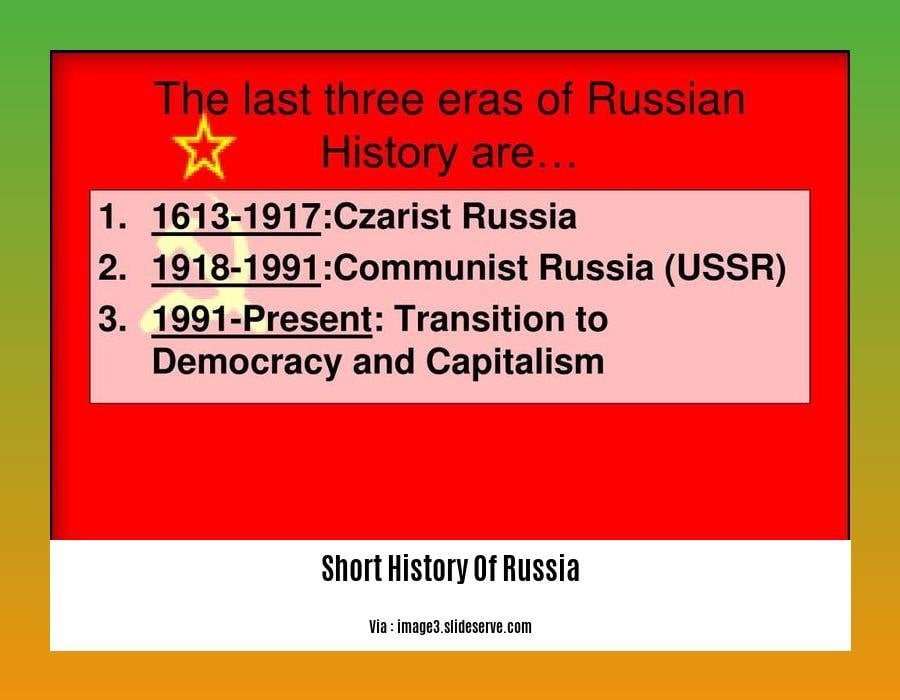
Before the 18th century, vast territories of present-day Russia were under the control of a series of Viking-descended warrior-princes who ruled from their capital, Kiev. By the 13th century, the powerful Mongol Empire swept over the region, ruling for over two centuries.
The year 1547 marked the beginning of a new era as Ivan IV, also known as Ivan the Terrible, unified the fragmented Russian lands and proclaimed himself the first Tsar. His expansionist policies laid the foundation for the sprawling empire that would come to be.
The 18th century witnessed the rise of Peter the Great, who embarked on an ambitious campaign of modernization and Westernization. During his reign, the Russian Empire expanded its reach into the Baltic Sea region, with the newly established city of St. Petersburg serving as its symbolic capital.
The 19th century brought forth a succession of powerful female rulers, including Catherine the Great, who expanded the empire’s borders while promoting enlightenment values. Under her leadership, Russia became a major player in European affairs.
At the turn of the 20th century, Russia found itself embroiled in the First World War, aligning with the Allied Powers. However, the war took a heavy toll, contributing to widespread discontent among the Russian populace.
In 1917, the Russian Revolution erupted, leading to the overthrow of the monarchy and the establishment of the Soviet Union. The Bolshevik Party, led by Vladimir Lenin, seized power and embarked on a radical experiment in communism, transforming Russia into a totalitarian state.
The Soviet Union emerged as a global superpower during the Cold War, rivaling the United States for geopolitical dominance. However, the strain of maintaining this superpower status, coupled with internal economic and political problems, eventually led to its collapse in 1991.
The dissolution of the Soviet Union marked the birth of the Russian Federation, which inherited the bulk of the former superpower’s territory and nuclear arsenal. Since then, Russia has been navigating the challenges of political and economic transformation, while asserting itself as a major player on the world stage.
Before exploring Russia’s rich history, gain insights into the evolution of English society through the Middle Ages and early modern times by visiting our dedicated page: social history of England questions and answers.
Did you know England’s history can be condensed into a captivating narrative? Immerse yourself in the shortest history of England and discover the nation’s journey from its humble beginnings to its rise as a global power.
**Short History of Russia: Unveiling a Complex Tapestry of Power, Expansion, and Transformation**
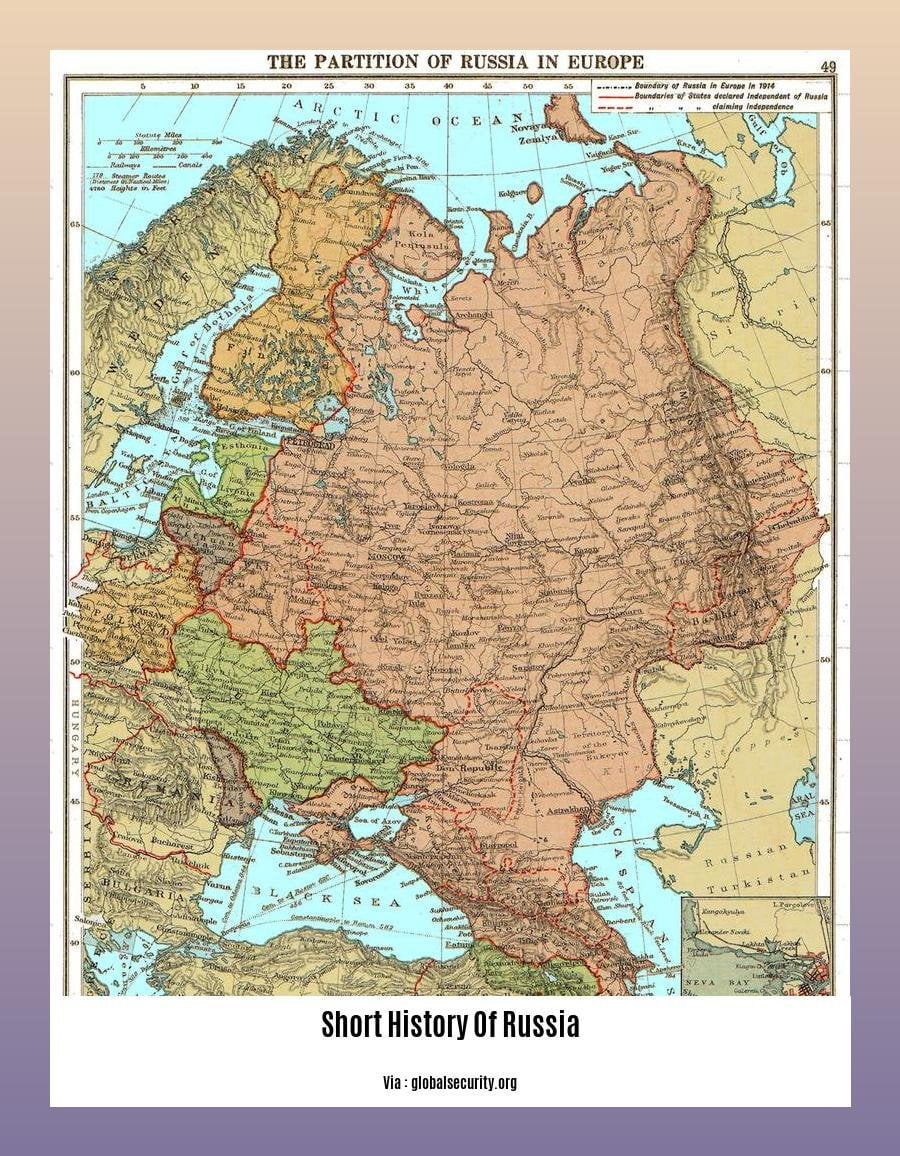
Key Takeaways:
Russia’s vast history is a testament to its endurance, resilience, and profound impact on the global stage.
From the tsars’ rule to the Russian Revolution and the rise of the Soviet Union, Russia’s journey has been marked by both triumphs and hardships.
Its rich tapestry of ethnicities, cultures, and traditions has shaped a nation that continues to captivate the world’s imagination.
Russia’s history is a captivating narrative that spans centuries, encompassing the rise and fall of empires, sweeping social transformations, and the birth of a modern nation-state. The journey begins with the founding of Kievan Rus in 862 AD, a pivotal moment that laid the foundation for Russia’s emergence as a powerful state.
Over the centuries, Russia’s borders expanded rapidly, incorporating diverse regions and cultures under its rule. This expansion was driven by a combination of factors, including the need for security, access to resources, and the desire to assert its influence on the global stage.
The reign of Ivan the Terrible in the 16th century marked a significant turning point in Russian history. His ruthless and ambitious rule ushered in a period of centralization and modernization, transforming Russia into a formidable empire.
The 18th and 19th centuries witnessed the rise of the Russian Empire, a period of unprecedented expansion and territorial conquests. Under the leadership of Peter the Great and Catherine the Great, Russia emerged as a major European power, exerting its influence on the continent and beyond.
The early 20th century brought about a tumultuous period of revolution and upheaval. The Russian Revolution of 1917 toppled the monarchy and gave birth to the Soviet Union, the world’s first communist state. The Soviet era was marked by rapid industrialization, the rise of a totalitarian regime, and a profound impact on global politics.
The collapse of the Soviet Union in 1991 marked the end of an era and the beginning of a new chapter in Russian history. The post-Soviet period has been characterized by economic and political challenges, as well as a resurgence of Russian nationalism.
Today, Russia stands as a major player on the world stage, with a rich history that continues to shape its identity, culture, and global influence.
Citations:
- A Short History of Russia
- The History of Russia
Short History of Russia Wikipedia
Imagine a country that spans across 11 time zones, has a rich history dating back over a thousand years, and has played a pivotal role in shaping the world as we know it. That’s Russia, a nation that has seen tsars, revolutions, and emerged as a powerful force on the global stage.
Key Takeaways:
The history of Russia is a captivating journey through diverse cultures, vast territories, and a series of transformative events.
The establishment of Kievan Rus’ in 862 AD marked the rise of a powerful state in Eastern Europe.
Ivan the Terrible’s reign in the 16th century centralized power and ushered in a period of modernization.
The Russian Empire expanded rapidly in the 18th and 19th centuries, becoming a dominant force in Europe.
The Russian Revolution of 1917 toppled the monarchy and gave birth to the Soviet Union, reshaping global politics.
The collapse of the Soviet Union in 1991 marked the end of an era, paving the way for the emergence of modern-day Russia.
The Seeds of a Nation
Russia’s story begins with the arrival of the Eastern Slavs around the 5th century. They settled in the vast plains of Eastern Europe, forming various tribes and principalities. In 862 AD, a Viking chieftain named Rurik established the Rurik Dynasty, marking the foundation of Kievan Rus’, the first major East Slavic state.
The Rise of Moscow
Over the centuries, Kievan Rus’ fragmented into smaller principalities, each vying for power. One of these principalities was Moscow, which gradually rose to prominence under the leadership of Ivan III (1462-1505). Ivan expanded Moscow’s territory, centralized power, and laid the foundation for the Russian Empire.
The Reign of Ivan the Terrible
Ivan IV, known as Ivan the Terrible, ascended to the throne in 1547. His reign was marked by both ruthless brutality and progressive reforms. He conquered vast territories, including Siberia, and introduced sweeping changes in administration and military organization.
The Russian Empire
Under Peter the Great (1682-1725), Russia embarked on a period of rapid modernization. He reformed the government, established a modern army and navy, and expanded the empire’s borders. Catherine the Great (1762-1796) continued this expansion, extending Russia’s influence into the Black Sea region and beyond.
Revolution and the Rise of the Soviet Union
The 19th century saw the rise of revolutionary movements in Russia. The Russian Revolution of 1917, led by Vladimir Lenin and the Bolsheviks, overthrew the monarchy and established the Soviet Union, the world’s first communist state. The Soviet era was marked by rapid industrialization, collectivization of agriculture, and the rise of a totalitarian regime under Joseph Stalin.
Modern-Day Russia
The collapse of the Soviet Union in 1991 marked the end of the Cold War and the beginning of a new era for Russia. The country faced economic and political challenges as it transitioned to a market economy and democracy. Today, Russia stands as a major player on the world stage, with a rich history that continues to shape its identity, culture, and global influence.
Sources
History of Russia – Wikipedia
Russia – History
FAQ
Q1: Can you give me a brief overview of Russian history?
A1: Sure. Russian history can be traced back to the 9th century when the Vikings established the Kievan Rus state. Over the centuries, Russia expanded its territory and became a major European power. The 20th century was marked by the Russian Revolution and the rise of the Soviet Union, which dissolved in 1991, leading to the establishment of the Russian Federation.
Q2: What were some of the key events in Russian history?
A2: Some of the key events in Russian history include: the Mongol invasion in the 13th century, the reign of Ivan the Terrible in the 16th century, the Time of Troubles in the early 17th century, the reign of Peter the Great in the 18th century, the Napoleonic invasion of 1812, the Russian Revolution of 1917, the rise of the Soviet Union, and the dissolution of the Soviet Union in 1991.
Q3: What are some of the unique characteristics of Russian history?
A3: Some of the unique characteristics of Russian history include: its vast size and diversity, its strong sense of nationalism, its history of expansionism, its experience with communism, and its complex relationship with the West.
Q4: What are some of the challenges facing Russia today?
A4: Some of the challenges facing Russia today include: economic stagnation, political instability, corruption, demographic decline, and the rise of nationalism.
Q5: What are some of the sources that I can use to learn more about Russian history?
A5: There are many sources that you can use to learn more about Russian history, including books, articles, websites, and documentaries. Some of the most popular books on Russian history include: “A History of Russia” by Nicholas V. Riasanovsky, “The History of Russia” by Robert K. Massie, and “Russia: A Thousand-Year History” by Martin Sixsmith.
- China II Review: Delicious Food & Speedy Service - April 17, 2025
- Understand Virginia’s Flag: History & Debate - April 17, 2025
- Explore Long Island’s Map: Unique Regions & Insights - April 17, 2025
